AMD Ryzen 7 7840HS Performance
Instead of going through the entire Linux-Bench test suite, we are going to show a few performance and power numbers here to give a general sense of performance. This also gives us the opportunity to test with Linux/ Ubuntu instead of just Windows.
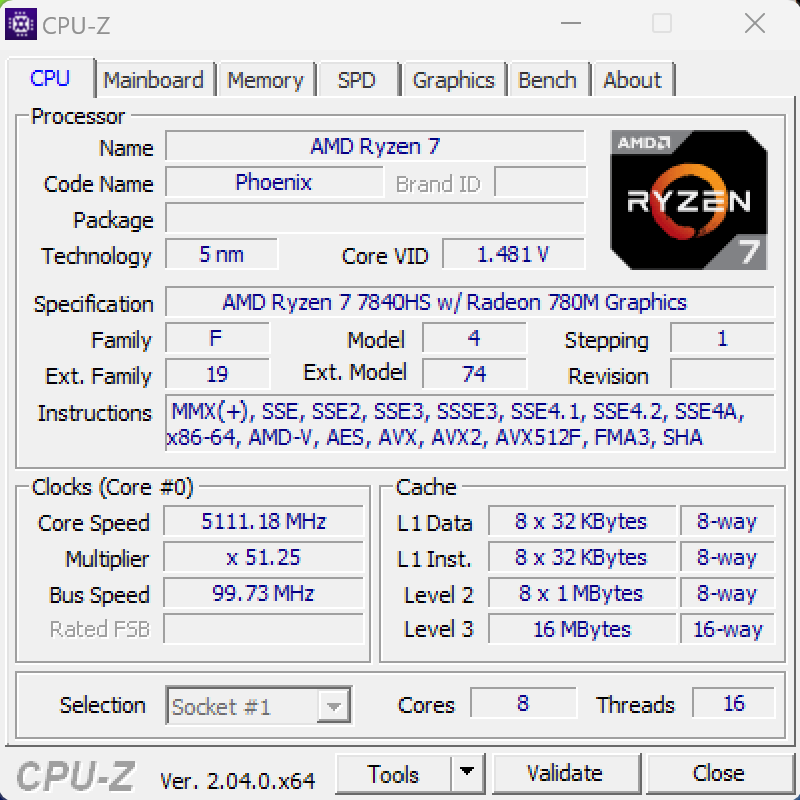
Something that we were surprised about was that the system will let the Zen 4 cores run at 5.1GHz frequently. Beelink seems to have improved cooling and is pumping a lot of power into these systems to allow this to happen.
Python Linux 4.4.2 Kernel Compile Benchmark
This is one of the most requested benchmarks for STH over the past few years. The task was simple, we have a standard configuration file, the Linux 4.4.2 kernel from kernel.org, and make the standard auto-generated configuration utilizing every thread in the system. We are expressing results in terms of compiles per hour to make the results easier to read:
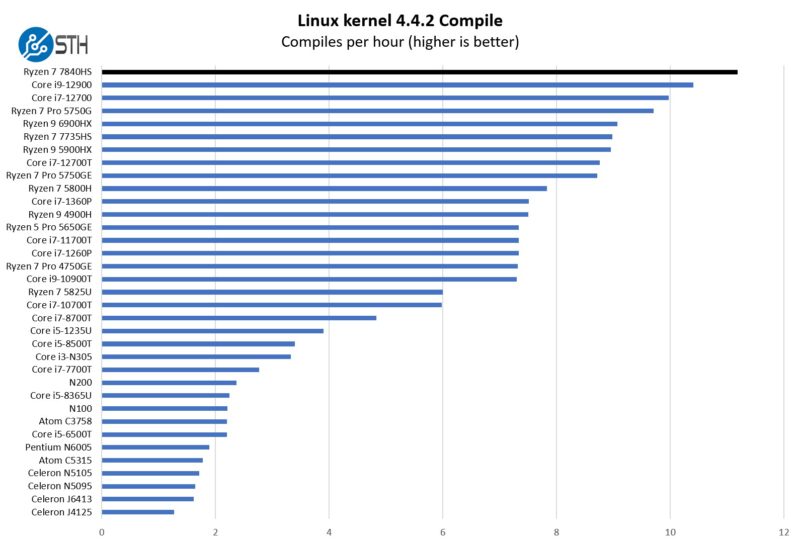
The AMD Ryzen 7 7840HS is a very fast chip. With its Zen 4 architecture, the CPU is very fast.
7-zip Compression Performance
7-zip is a widely used compression/ decompression program that works cross-platform. We started using the program during our early days with Windows testing. It is now part of Linux-Bench.
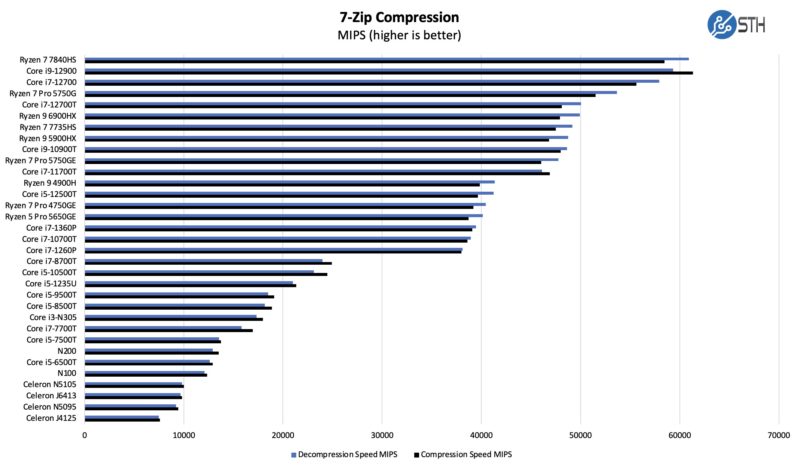
While this CPU is topping our charts at the moment, we wanted to point out that there are faster CPUs. We just have not tested them in mini PCs as they often use more power.
OpenSSL Performance
OpenSSL is widely used to secure communications between servers. This is an important protocol in many server stacks. We first look at our sign tests:
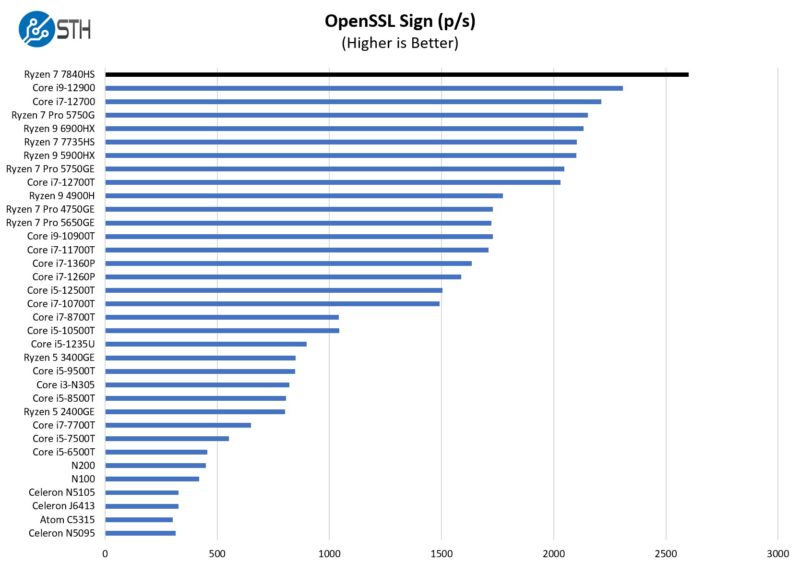
Here are the verify results:
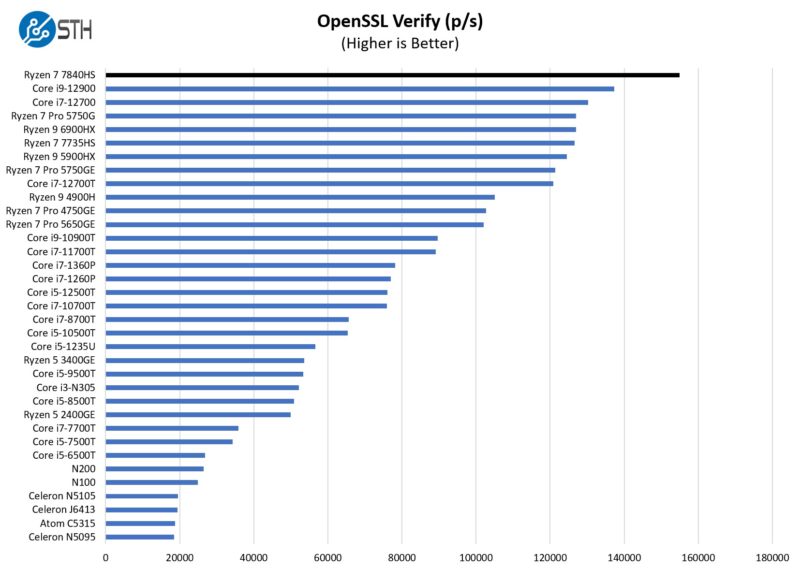
Overall, that is a great performance on the CPU side.
Crucial P3 Plus 1TB Performance
We mentioned this earlier, but we just wanted to see how the Crucial P3 Plus performed. It is certainly PCIe Gen4, but it is also not the fastest.
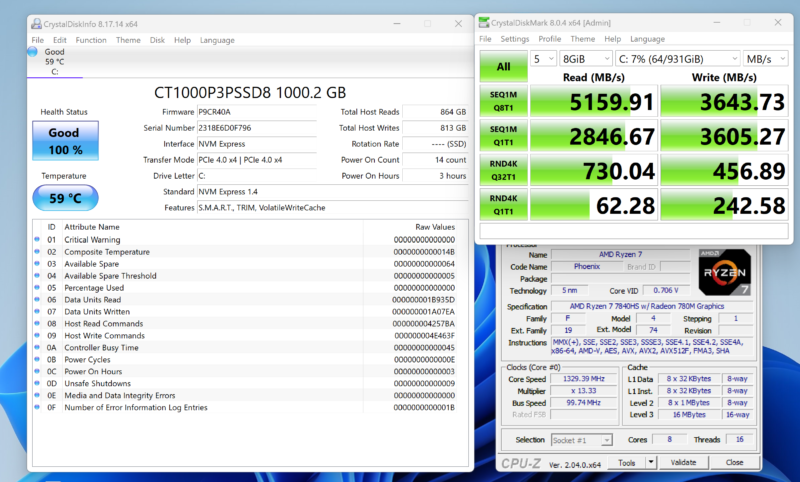
You can find Will’s full Crucial P3 Plus 1TB PCIe Gen4 NVME SSD Review for more detail on that drive.
A Word on the AMD RDNA 3 GPU
By far, the biggest update to the mini PC is not the Zen 4 CPU that is still 8 cores/ 16 threads albeit a bit faster than previous generations. Instead, it is the integrated AMD Radeon 780M based on RDNA 3. This is a great example of one of the features we get with the new GPU, the ability to use not just AV1 decode, but also encode.
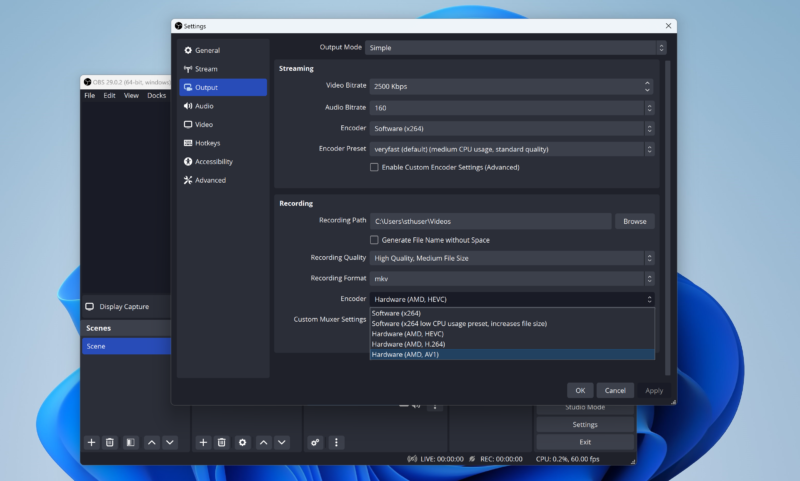
In the video, we show our mini PC League of Legends test that we captured using AV1 encode via OBS.
The League of Legends testing was funny. We use that because folks asked for gaming, and it is a massively popular title that also is within the realm of running on mini PCs. When we started, running 1080p at solid framerates with high settings was just about achievable. When we ran the GTR7, we thought there was no gain because we saw 70-90fps similar to the GTR6. Then we realized that the GTR7 was doing this at 4K instead of 1080p. This was a very solid performance by RDNA 3.
Geekbench Performance
Geekbench 6 just underwent a 6.1 update that changed numbers. Instead, we wanted to show Geekbench 5 results for the GTR6 and GTR7.
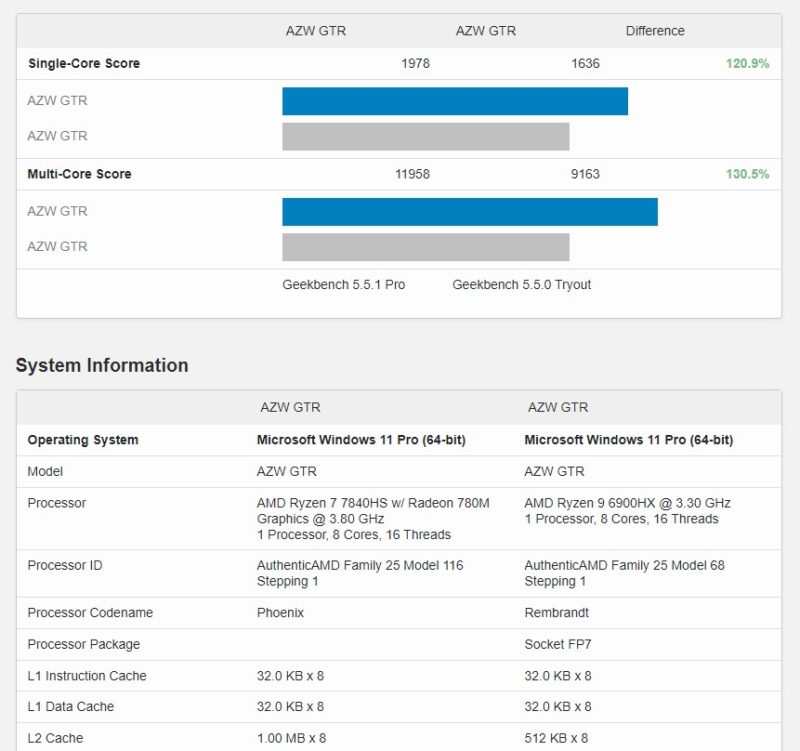
The Geekbench results are very good. Part is architecture. Part is cooling and power limits.
On the RDNA 3 graphics side, here is one that we saw that was a bit shocking.
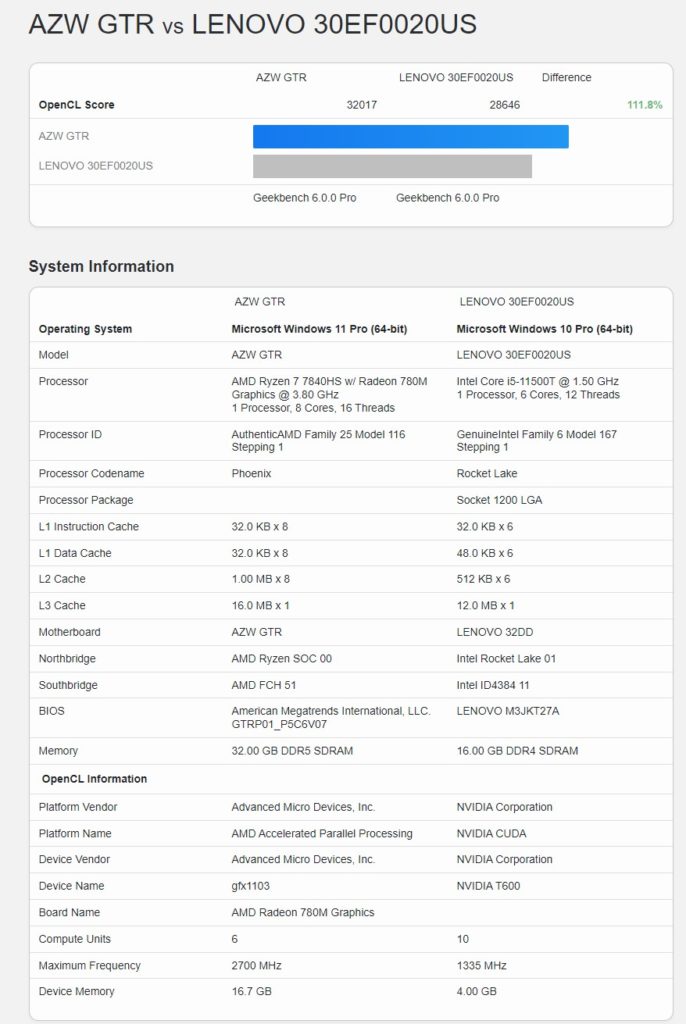
That is the Lenovo P350 Tiny that will be part of our Project TinyMiniMicro series with a NVIDIA T600 dGPU. That is an integrated GPU not only running with a 40W dGPU, but it is actually coming out ahead on Geekbench 6 OpenCL benchmarks. That is almost shocking.
Next, let us see how this performance translates to performance and noise.




STH, while your TinyMiniMicro series has now achieved the legendary status, I’d really appreciate some clarity in your reviews around the support Beelink, Minisforum, and all others of these type of vendors provide. I personally went for Intel NUC. Most other -consumer- vendors hardly ship bios upgrade and the platform firmware upgrades are simply not existing. Issues like the i225/i226 disconnection have definitely improved iteration over iteration of newer drivers and firmware.
What was the trick to get the AMD drivers to work? I bought the PRO version to put in front of my TV for gaming and want to immediately reload this machine upon reception due to it coming from China and who knows what is all installed on this thing.
can someone make me clear why these day’s we still have usb 2.0 ports?
it is waste of space. just put usb 3.0 or 3.1 or 3.2. every version beyond usb 2.0 is better than usb. 2.0.
every OS supports booting from usb 3.x.
Erik, usb2.0 exists to connect keyboard and mouse.
Federico – it is nowhere near what Lenovo, HP, and Dell provide. You are right. On the other hand, you get more performance per dollar with these by a notable margin when the systems are at new pricing.
Churchill – See the EQ12 Pro video. You may want to see if you can grab the Windows 11 Pro key before re-installing it. Otherwise, you probably have to contact support. The basic VGA drivers and such worked out of the box. We tried installing the software via the installer and it worked after a reboot at some point.
erik – I think gdfsg hit that one perfectly. The USB 2 is there so you do not have to use USB 3 for keyboard and mouse.
It would still be good if you always have a section pointing out track records of updates/unpatched vulns across all your reviews as a subtle pressure on the manufacturers. These mini pcs are the most notorious but I’d imagine it’s relevant to discuss with even network/security vendors (unpatched vuln track record)
Looks cool, but why is there a CMOS clear button *right next* to the power button on the front?
I would *so* bump or mistakenly press that… It’s not often used, it should be inside.
I have both Minis Forum and Beelink mini-PC’s and the support for the most part is by web forum or email. Issues usually only come up when you push these little boxes out of their niche. (Windows/Gaming/general desktop)
Minis Forum has encouraged people to install Linux and post their results so all can see. I typically run Proxmox on them and you have to make some boot adjustments becuase Proxmox isn’t really about the latest and greatest video drivers. Some Linux flavors work great, some don’t. Let the buyer decide essentially.
VMWare 7.x with the Fling Pack works fairly well on these too and has been very, very stable.
The area that gets the least amount of feedback on these is the use of Thunderbolt and the USB4 port. Everyone wants to know if their legacy Thunderbolt device will work on that port. And for the life of me I can’t understand anyone who would plug in a $1000 GPU in a TB dock and then chicken choke it through Thunderbolt.
What about thermals under load especially ddr5? Some reviews point to 90+ degrees on the ddr5. Also, the cpu seems to throttle. You can tell that by looking at 3d mark results on other reviews. The cpu frequency is not steady on the last portion of the test.
THN – We did not see this. Just for some sense, I logged into the system remotely right now, at ~25% workload and the DDR5 has been sitting at 37-39.5C.
We will try to reproduce it with the GTR7 Pro. The Minisforum UM690 Pro throttled so badly during even LoL testing that the framerates dropped well below other machines with the same CPU. That did not happen on the GTR7. I would check if anyone claiming 90C+ memory on these also saw it on the UM690 Pro since that does not have a bottom fan like this does.
The CPU “throttled” only from a 5.1GHz to 4.7GHz even under 100% load to keep the system under 100W.
Could someone please explain why USB 2.0 ports are still used today?
It’s a waste of room. just insert a USB 3.0, 3.1, or 3.2. Every version of USB after 2.0 is superior than USB. 2.0.
There’s a comment and answer on USB2 already. It’s for kbd/mouse
@Churchill, i always put a fresh Lonux installation on all machines to make sure no American can listen in. No American can be trusted, and as soon as a Chinese company makes decent machines I will get rid of all thins American
This “Mobile” BGA Packaged APU has been allotted a 65W cTDP which is the same wattage as AMD’s “Desktop” G series Socket Packaged APUs and really there’s no difference in the silicon utilized in the Ryzen APUs, Mobile BGA Packaged or Desktop Socket Packaged APUs but that cTDP mostly.
And ETA Prime reviewed this SKU and was able to up the cTDP in the BIOS to 75W for gaming but this SKU is not processor upgradable like the ASRock Desk Mini(STX MB) or an InWin Chopin(Mini-ITX MB) based! And AMD has not been as DIY friendly there since AMD released its Ryzen 4000G but as OEM Only. And I purchased an ASRock X300/AM4 Desk Mini that came out of the box with Ryzen 4000G support in the BIOS expecting that I would be able to get a consumer Non Pro Ryzen 4000G variant only to find out that Ryzen 4000G was OEM only and in the Pro Branded form there that’s OEM and not consumer DIY. And it was not until Ryzen 5000G arrived that AMD actually made some Ryzen 4000G SKUs available for Processor in box DIY friendly availability and Ryzen 5000G was made OEM only for its first 3 months of availability until being offered to the DIY system builder consumer market,
So really I’m now wondering if AMD’s Socket based line of Desktop APUs are ever going to be updated beyond that Ryzen 5000G/Vega 8CU integrated graphics on the AM4 platform as AMD’s not released any Ryzen 6000G(Zen-3+/RDNA2 12CU) or Ryzen 7000G(Zen-4/RDNA3 12CU) based Desktop APUs in socket packaging there for AM5.
And I do hope that Intel with its Meteor Lake offerings will at least offer some Socket Packaged Meteor Lake variants and Intel’s well capable of socket packaging any mobile APU as I’m still using an HP Probook(4540s) with an Ivy Bridge generation core i7 3632QM processor that’s Socket Packaged and can get replaced or upgraded there on that good old fashioned workhorse HP Probook laptop.
But AMD’s increasingly becoming DIY end user unfriendly and appears to want to cater to OEM’s more and consumer DIY less and that’s Bad news there for folks Building InWin Chopin based systems where even though that takes a Mini-ITX MB the Chopin lacks the room for a Discrete GPU so really needs a Desktop APU for the Integrated Graphics and the ASRock Desk Mini uses an STX MB form factor there so needs G series Desktop APUs, or the Intel equivalents.
And really I’m very much hoping that Intel will release some Meteor Lake socket packaged SKUs for InWin Chopin and ASRock Desk Mini DIY system builders(Desktop APUs/SOCs in Socket Packed form with powerful integrated graphics) as otherwise AMD’s not going to be motivated to move beyond only offering Ryzen 5000G/Vega 8CU iGPU on the AM4 platform that’s 2 generations old for Integrated graphics(Vega). If Meteor Lake is only available in BGA packaging then AMD’s got not much motivation there to respond for lack of competitive pressures to offer any yearly Desktop G series APU update cadence and Vega 8CU iGPUs still compete well against any current Intel 96EU based integrated graphics.
My experience with Beelink was less than stellar. I purchased a GTR 7 Pro version and after hassling with tech non-support for over a week, I gave up and sent it back. One problem was no video output on one HDMI and tech support asked me to take a screengrab/photo of the blank screen….really? We played the 20 questions routine and then they wanted me to purchase new video cable, new memory and storage – to test with. What? It came with memory and storage installed from them. Yeah – not a good experience at all.
They are not worth the hassle. Went with two mini’s from Minisforum. Tech support was needed for a UUID conflict with Synology NAS backups. They responded quickly with a software tool to modify the UUID in the BIOS and that solved the problem. Both systems running great and I have Win11 on one and Win10 on the second.
How does this perform when compared to an M2 Pro Mac Mini?
Can it fit double sided nvme’s pr only single sided?